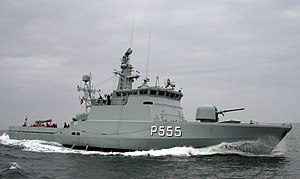Flyvefisken class patrol vessel

P555 HDMS Støren
|
|
| Class overview | |
|---|---|
| Name: | Flyvefisken class |
| Operators: | |
| Subclasses: | Tejo class (Portugal) |
| Built: | 1985–1995 |
| In commission: | 1989– |
| Planned: | 17 |
| Completed: | 14 |
| Cancelled: | 3 |
| Active: | 9 |
| Retired: | 1 |
| Preserved: | 3 (for sale) |
| General characteristics | |
| Type: | Patrol vessel |
| Displacement: |
|
| Length: | 54 m (177 ft 2 in) |
| Beam: | 9 m (29 ft 6 in) |
| Draught: | 2.5 m (8 ft 2 in) |
| Propulsion: |
|
| Speed: |
|
| Range: | 3,860 nmi (7,150 km) at 18 kn (33 km/h; 21 mph) |
| Complement: | 19-29 depending on role |
| Sensors and processing systems: |
|
| Armament: |
|
The Flyvefisken-class patrol vessels ("Flying fish" in Danish) are warships of the Royal Danish Navy. The class is also known as the Standard Flex 300 or SF300 class. The four vessels sold to the Portuguese Navy are locally referred as Tejo class.
The Flyvefisken ships were constructed using an innovative modular design known as StanFlex: they have a standard hull in which containerised weapons or systems can be placed. This allows them to rapidly change roles, typically in 48 hours. This enables the ships to be configured to perform the following roles:
The containers measure 3.5 by 3 by 2.5 metres (11.5 ft × 9.8 ft × 8.2 ft). One container is situated on the foredeck; the other three go on the quarterdeck behind the superstructure and funnel. Furthermore the ships are built using the sandwich principle - a layer of fiberglass either side of a core of PVC cell foam. This forms the structure from keel to top of mast. This building method reduces maintenance costs - so much so that 20 years later the new Diana and -Holm class have been built using the same materials.
The Flyvefisken class replaced three different vessels in the Danish Navy: Six torpedo boats of the Søløven class (1965–90), six coastal minesweepers of the Sund class (1955–99) and eight seaward defence craft of the Daphne class (1961–91). It was possible because of the containerised systems and modern technology.
The replaced vessels used World War II (or World War I) tactics: The Søløven boats were light plywood boats propelled by three turboshafts, which attacked the enemy ships with torpedoes in 54-knot (100 km/h; 62 mph) hit-and-run attacks. The Flyvefisken class is not that fast, but their Harpoon missiles are sufficient for the task.
...
Wikipedia
